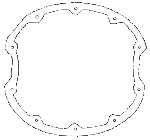

Possibly this could help out some of you guys that want to pop the covers & count your teeth. Expect all pages to be updated once I start finding out which gears were available for specific years & models. So with a little investigating (and a Sherlock Holmes hat), you should be able to determine the exact origins of your housing.^^^I only updated on the Chevrolet page for now since this is just generic info. I have a 10-bolt stamped “GZ”, which identifies it as a 2.73:1 open, 8.5-inch rear-end that came out of a 1972 Camaro.
GM REAR END CASTING NUMBERS DECODE CODE
The code was a 2PYG number which we deciphered as an 8.5-inch 10-bolt with a 3.42:1 gear and posi-traction from a 1975 Camaro. We measured the housing width and also the center-center distance of the leaf springs and then ran the code. He had 10-bolt of unknown origin and needed to verify what it was. A year or so ago, a friend asked for help with a similar problem. So you might be able to track down your rear-end housing using this code.

But to give you an example, if the axle housing were an early Camaro 8.2 10-bolt, a “PA” stamp in the leading edge of the passenger side axle tube would represent a 3.08:1 rear gear. There are literally hundreds of these codes for the three different 10-bolt rear-end housings we’re discussing here, so it’s beyond the scope of this answer to list all of them. That may be the same number used in Novas, but we’re not clear on that.Īnother clue to the rear-end’s heritage is located on the passenger side tube as code stamps in the tube itself. For the 1972-75 Camaro style model 8.5-inch 10-bolt casting numbers we’ve found a 410409N and a 410408N. If it is an early 8.2-inch 10-bolt Camaro housing, the casting number will be 3894859NF. First, look at the casting number of the center section. So let’s assume that the 10-bolt you have has the narrower 42 7/16-inch leaf spring centerline spec. You can add strength by bolting in this corporate 8.5-inch 10-bolt. This is a somewhat common swap for early Camaros when a 12-bolt is out of the budget range. The reason for this is that the early 8.2-inch 10-bolts for the 1968-69 Camaros were this width, but this is also the spec of a later corporate 8.5-inch 10-bolt out of a 1972-75 Nova.

If, on the other hand, the rear-end measures only 42 7/16-inches, then we have to do some additional investigating. If the housing measures 45 3/8-inch between the centerlines of the leaf spring perches, then this is a GM corporate 8.5-inch 10-bolt for a second generation Camaro. So the first thing you can do is to measure the distance between the centerline of both leaf spring perches. That identifies it at least as potentially intended for a Camaroor a last generation (1972-75) Nova. First, we’ll assume that it is a 10-bolt with leaf spring mounts welded to the housing. Since the housing is bare, with no gears or components, let’s first look at the housing itself.
GM REAR END CASTING NUMBERS DECODE HOW TO
So let’s look at how to identify your 10-bolt. So that should indicate that this rear-end assembly is more than durable enough for a very strong street car. We know a Super Street drag racer who continues to this day running a mid-8-second, second generation Camaro that uses a near-stock configured 8.5-inch 10-bolt. While many believe that the later corporate 10-bolt is as weak as the earlier 8.2, this is not the case. As with all GM Salisbury rear axle assemblies, the number of bolts, in this case 10, refers to both the ring gear bolt count and the number of bolts retaining the rear cover. The new corporate 10-bolt started with a medium, 8.5-inch ring gear diameter but retained the 12-bolt’s pinion shaft diameter of 1.625-inches to give it strength. Then in 1971, GM corporate decided they didn’t need two different axle housings so they merged the 10-bolt with the 12-bolt. These two rear axle combinations continued from 1965 through 1970 even with the coming of the second generation Camaro in 1970. The 12-bolt was the performance axle assembly reserved for high output small-block and all the big block cars employing a larger 8.875-inch diameter ring gear and 30-spline axles. This assembly used an 8.2-inch ring gear diameter and 28-spline axles for Camaros, Chevelles, Impalas and even the early Chevy II’s. The 10-bolt was used in all the low performance applications. Jeff Smith: When Chevrolet built the first Camaros in 1967, they were already in production of both 10- and 12-bolt rear-end housings. How do I identify this as either an 8.2-inch or perhaps an 8.5-inch 10-bolt? I’ve heard those later 10-bolts are stronger, but I don’t know much about them. I purchased a ’68 Camaro basket case along with a pile of parts including what appears to be a 10-bolt rear-end that was not under the car.


 0 kommentar(er)
0 kommentar(er)
